I think I have never been so amazed by the software I reviewed. Before I start with a review I have to admit something. My first thought, when I saw Adaxes was that it’s complicated, slightly outdated tool. I guess because I am so used to web based tools. But after 5 minutes with the product it changed my mind. To my amazement, Softerra Adaxes is not one, but more like 3 products in one. Let me explain.
Main product is AD management and provisioning tool. Second product that could be sold separately is account password expiration tool. You see, there are products that are being sold and do one thing only – notify users about expired passwords. Third tool that is part of the product is AD self-service. Again, many companies sell a separate product for AD Self Service.
Softerra Adaxes Review – features and solutions to your problems
One of the problems every IT department will face, have faced or is now facing is that companies have cut budgets for IT, in turn, IT staff have less time and need a way to automate as much as possible. Once you reach a point that you know that automation will save you a lot of time, you ask yourself what can I automate? You probably automated standard programs, patches and computer images deployment.
But looking at Helpdesk/Service Desk reveals a different picture. I don’t know what is a percentage of all requests relating to password reset and account lockout requests in your case, but I know that in my case, it’s a lot. Looking further, a lot of tickets relate to new users. Either opening up account and/or emails. If I can get those requests down by half, my team can start to breathe.
Regardless, my goal is to reduce user related tickets to a minimum. As a prevention, I would like to help my users remember to change the password before it expires.
There are at least two problems that Softerra Adexas can solve in addition to automation, Self-service notification – Security and licensing
When your employees leave there are certain actions you must do, for example, you have to deactivate an account. If you don’t, there is a possibility that ex-employee would log on and harm the system. If you don’t follow the procedure, active users that are no longer with the company if could pose problem. And not only for the security. There are the auditors who could find them as still being active and that is never good thing.
On the other hand, if you have users that are active but are no longer present with the company, they still count as a license. Either user CAL, Exchange CAL or Office 365 CAL.
AD and automation
First feature that got me excited about the product is called After User Creation. You see, every time I create a new user, I have many post actions that I have to do to complete a task. I always thought how much I would love the product that would take part of that burden away. Softerra Adaxes is a first product that makes my wish come true. You can assign tasks that can be automatically made after you create a user. When user is created, Adaxes can create home share and automatically map it for the user. What’s more, you can automatically create Exchange mailbox, you can automatically enable user for Lync and even activate user for Office 365 account. You can assign many operations including sharing home directory and many additional tasks.
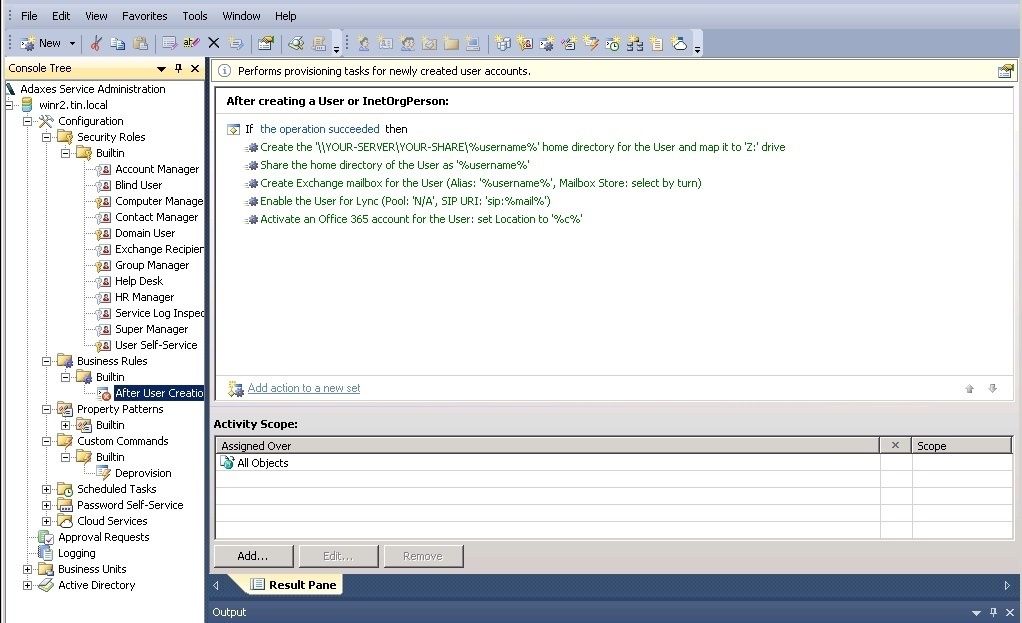
When it get’s more interesting is when you need to deprovision a user. Let’s take a look at the actions that are available to you when a user leaves the company. When you need to disable the user the following tasks can be done automatically. User account will get disabled, User Password will be reset, account expiration date will be set for the current date, description will be added to the user’s account – Deprovisioned on %datetime% by %initiator% %description% so that you know exactly when and who deprovisioned account. In addition, actions Delete share of the home directory of the User, Delete the home directory of the User, Disable the User for Lync, Deactivate Office 365 account of the user: set Sign-in status to Blocked in order to revoke all the licences.
Some admins don’t know about one neat feature of Exchange. When you disable a user with the mailbox, that user is still visible in Exchange Global Address Book. But the trick is that with Adexes you can automatically hide the user with the function: set Hide from Exchange address lists to True. Another welcome task you can automate is that if the user also had Exchange account, you can automatically forward emails to %manager%. But this is just an example, you can add additional actions to Deprovision action.
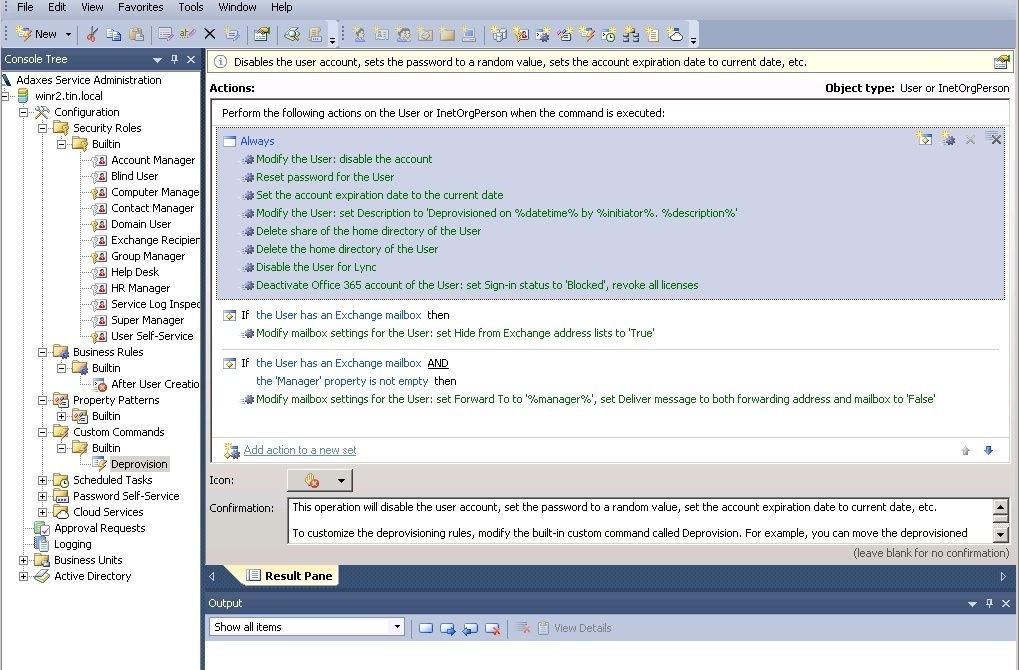
I mentioned Password Expiration Notifier before. You can notify users about Account expiration or Password expiration.

In case Manager is assigned to the user, you can set an action that the Manager receives the email, but you can also set IF statement that in case manager property is not present in AD, user is the one who will receive an email, think fallback.
You can also automate mundane tasks. You can automatically manage Inactive users and computers in order to prevent a mess in Active Directory and free some licenses as well. But there is one thing. Some users can go on a long vacation, there are also users going on a maternity leave. You don’t want to delete a computer or a user and create a problem. That’s why there is an elegant solution to prevent this kind of problems. First, when user or a computer is inactive for – define your time – account will first get disabled. Then description will get set to Inactive along with %datetime%. Once that action is completed there is the last action which first checks for minimum amount of time and only then delete account.
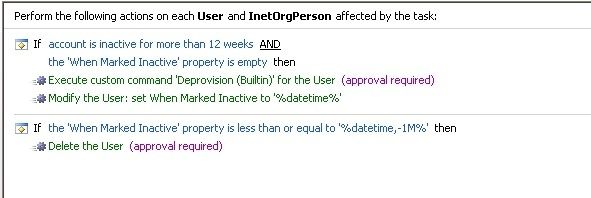
You can also add approvals to the mix. You can set that you have to confirm that account get’s disabled and deleted.
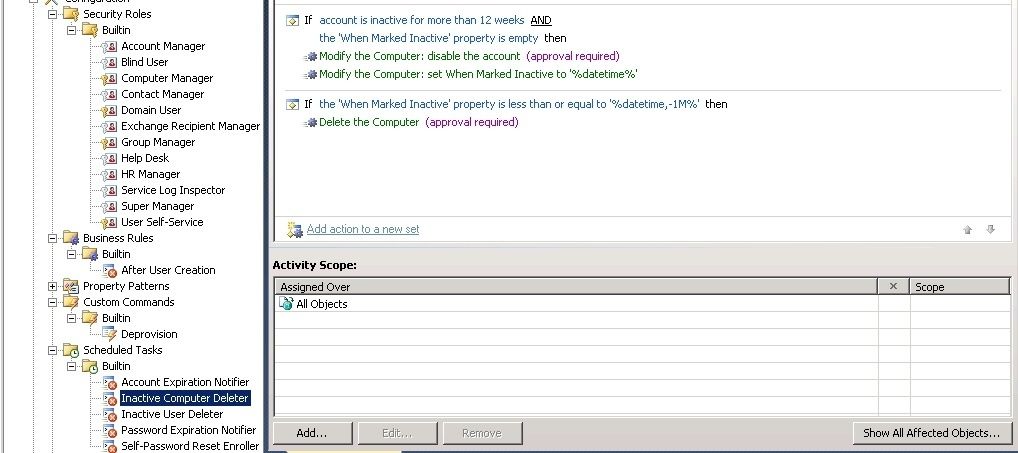
Self Service to the rescue
Since password related problems are still the major burden for IT teams around the world, priority for Help Desk managers is to transfer this task to the users. Self-Service can help. The idea behind Password Self-Service is quite simple. Most systems work very similar: Every user has first to enroll to the system. They have to define set of Questions and Answers and voila. They can unlock their account or set new password. In turn, they don’t create account lockout ticket.
Where Softerra Adaxes really shines is simplicity packed with features. It’s very simple to setup and use. But what struck me was when I discovered that it enables you to rebrand the UI completely, changing even the footer with the custom message. Also interesting is that when you log in for the first time, instead of a vendor Logo, you will find a simple logo called YOUR LOGO. It’s not easy for any brand to remove their Logos from the product. What’s important here is that they know their customers, they know end users and they know that they will trust the system if it’s branded with the company Logo’s and colors. While it’s a tiny feature it is executed perfectly.
Web interface is dedicated to three groups – Administrators, Help-desk and Self-Service. Each has it’s own URL and it’s dedicated to different users. It works like this: Administrator can manage everything. He can create OU’s, disable users, unlock users, Create users, Create Groups, Approve requests, Modify users, Create Mailbox and so on.
You assign a manager to every department. You can choose which actions can a Manager perform. But essentially a Manager would take care of his department.
On the other hand, Self Service portal enables users to manage personal information in AD, they can add information about organization, telephone number, Department, Surname, etc… but only if you set the policy in this way. You can control what users can and cannot do in self service portal.
Self Service functionality has the ability for users to unlock their account from the Windows login screen. You can set up a custom message to make it easier for users to understand what they have to do. Setting up this functionality is again very simple and easy to understand.
You can customize every aspect of the Self Service interface. You can set your own footer, Favicon, Help and Support links and can even display user images. A welcome addition is a button called – Apply to all web interfaces, so that you don’t have to customize the same thing three times.
Pricing and Conclusion
Softerra Adaxes is for me the biggest surprise in the last couple of years. I admit, at first I was a bit sceptical when I saw what seemed like a complicated interface. But after a minute with the program I fell in love and like every aspect of Adaxes. I am sure that every admin would benefit from the time saved.
I also like the fact that Softerra does not hide pricing. A gesture that is attributed to only of the finest companies.
I thought that such product would be very expensive but I think that it’s reasonably priced. Especially if you consider that it will save you a lot of time
| Package Type | Price (Perpetual License) |
Annual Maintenance and Support * |
|---|---|---|
| Packages for Small Businesses | ||
| Up to 100 user accounts | $1,600.00 | $480.00 |
| Up to 200 user accounts | $2,084.21 | $625.26 |
| Up to 400 user accounts | $3,052.63 | $915.79 |
| Up to 600 user accounts | $4,021.05 | $1,206.32 |
| Up to 800 user accounts | $4,989.47 | $1,496.84 |
| Up to 1,000 user accounts | $5,957.89 | $1,787.37 |
| Up to 1,500 user accounts | $8,378.95 | $2,513.68 |
| Up to 2,000 user accounts | $10,800.00 | $3,240.00 |
Adaxes received ITSMDaily 5 STAR Award, special award for products that are the best in it’s class.


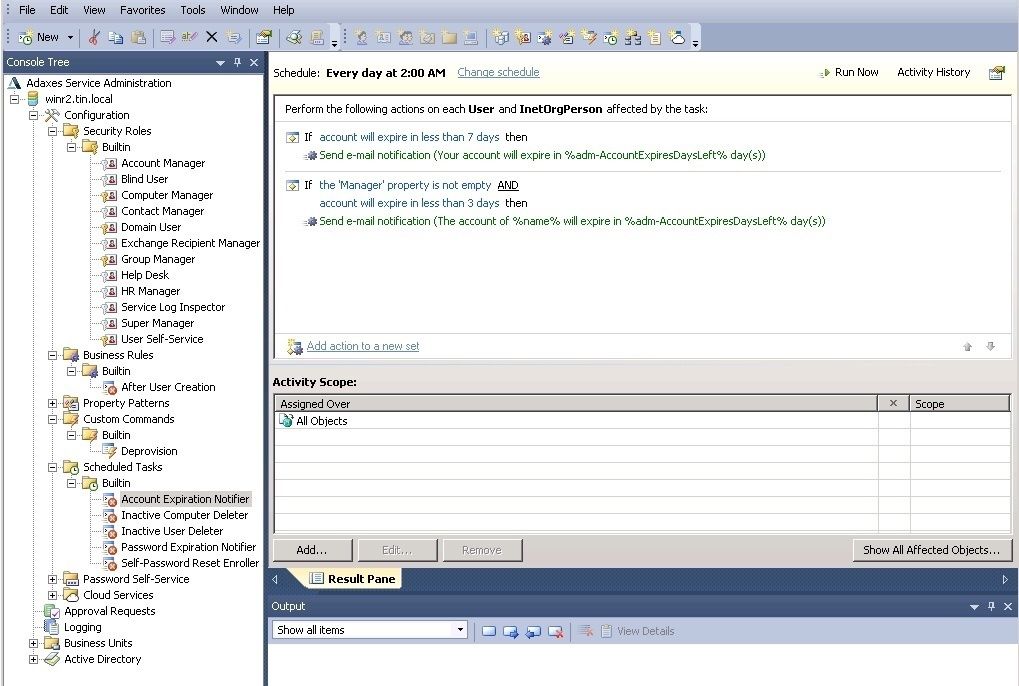

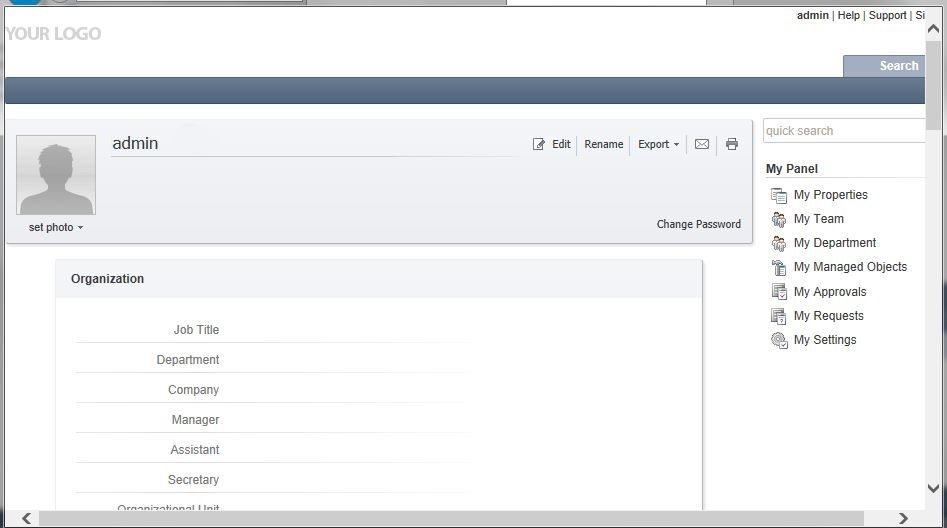
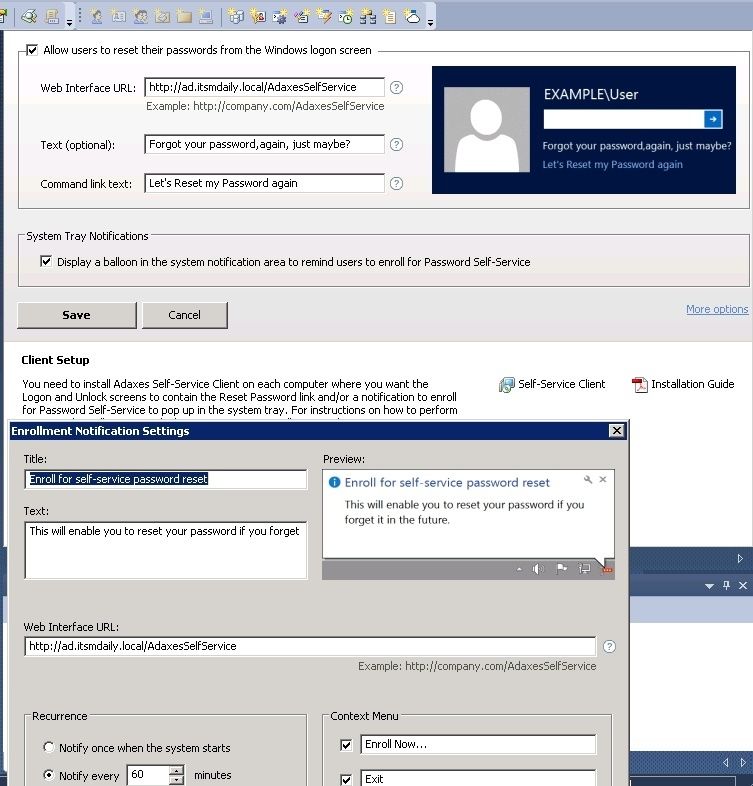
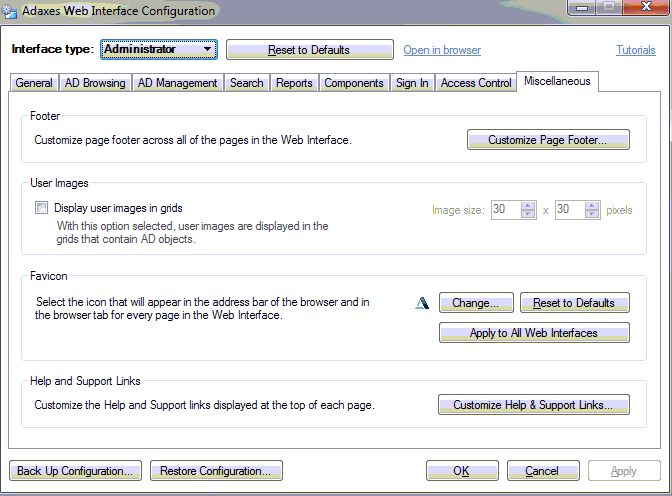

Schreibe einen Kommentar